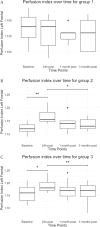Anaesthesia, not number of sessions, influences the magnitude and duration of an aHF-rTMS in dogs
- PMID: 28937993
- PMCID: PMC5609759
- DOI: 10.1371/journal.pone.0185362
Anaesthesia, not number of sessions, influences the magnitude and duration of an aHF-rTMS in dogs
Abstract
Background: Currently, the rat has been a useful animal model in brain stimulation research. Nevertheless, extrapolating results from rodent repetitive Transcranial Magnetic Stimulation (rTMS) research to humans contains several hurdles. This suggests the desperate need for a large animal model in translational rTMS research. The dog would be a valid choice, not only due to the fact that humans and dogs share a neurophysiological background, but a similar neuropathological background as well.
Hypothesis: In order to evaluate the feasibility of the canine rTMS animal model, this study aimed to evaluate the neurophysiological response in dogs on a, clinically used, accelerated high frequency (aHF) rTMS protocol. This aHF-rTMS (20 Hz) protocol was performed under anaesthesia or sedation and either 20 sessions or 5 sessions were given to each dog.
Methods: 21 healthy dogs were randomly subjected to one of the four aHF-rTMS protocols (1 sham and 3 active protocols). For each dog, the perfusion indices (PI), of a [99mTc]HMPAO scan at 4 time points, for the left frontal cortex (stimulation target) were calculated for each protocol.
Results: Concerning sham stimulation, the average PI remained at the baseline level. The main result was the presence of a direct transitory increase in rCBF at the stimulation site, both under anaesthesia and sedation. Nevertheless the measured increase in rCBF was higher but shorter duration under sedation. The magnitude of this increase was not influenced by number of sessions. No changes in rCBF were found in remote brain regions.
Conclusion: This study shows that, despite the influence of anaesthesia and sedation, comparable and clinically relevant effects on the rCBF can be obtained in dogs. Since less methodological hurdles have to be overcome and comparable results can be obtained, it would be acceptable to put the dog forward as an alternative translational rTMS animal model.
Conflict of interest statement
Figures




Similar articles
-
Accelerated HF-rTMS Modifies SERT Availability in the Subgenual Anterior Cingulate Cortex: A Canine [11C]DASB Study on the Serotonergic System.J Clin Med. 2022 Mar 10;11(6):1531. doi: 10.3390/jcm11061531. J Clin Med. 2022. PMID: 35329857 Free PMC article.
-
The Impact of Accelerated HF-rTMS on Canine Brain Metabolism: An [18F]-FDG PET Study in Healthy Beagles.Front Vet Sci. 2022 Feb 24;9:800158. doi: 10.3389/fvets.2022.800158. eCollection 2022. Front Vet Sci. 2022. PMID: 35280129 Free PMC article.
-
Changes in canine cerebral perfusion after accelerated high frequency repetitive transcranial magnetic stimulation (HF-rTMS): A proof of concept study.Vet J. 2018 Apr;234:66-71. doi: 10.1016/j.tvjl.2018.02.004. Epub 2018 Feb 14. Vet J. 2018. PMID: 29680396
-
Intensity-dependent regional cerebral blood flow during 1-Hz repetitive transcranial magnetic stimulation (rTMS) in healthy volunteers studied with H215O positron emission tomography: I. Effects of primary motor cortex rTMS.Biol Psychiatry. 2003 Oct 15;54(8):818-25. doi: 10.1016/s0006-3223(03)00002-7. Biol Psychiatry. 2003. PMID: 14550681 Review.
-
[Efficacy of repetitive transcranial magnetic stimulation (rTMS) in major depression: a review].Encephale. 2007 Mar-Apr;33(2):126-34. doi: 10.1016/s0013-7006(07)91542-0. Encephale. 2007. PMID: 17675907 Review. French.
Cited by
-
Accelerated high frequency rTMS induces time-dependent dopaminergic alterations: a DaTSCAN brain imaging study in healthy beagle dogs.Front Vet Sci. 2023 May 16;10:1154596. doi: 10.3389/fvets.2023.1154596. eCollection 2023. Front Vet Sci. 2023. PMID: 37261109 Free PMC article.
-
Neurostimulation as a Method of Treatment and a Preventive Measure in Canine Drug-Resistant Epilepsy: Current State and Future Prospects.Front Vet Sci. 2022 Jun 16;9:889561. doi: 10.3389/fvets.2022.889561. eCollection 2022. Front Vet Sci. 2022. PMID: 35782557 Free PMC article. Review.
-
Accelerated HF-rTMS Modifies SERT Availability in the Subgenual Anterior Cingulate Cortex: A Canine [11C]DASB Study on the Serotonergic System.J Clin Med. 2022 Mar 10;11(6):1531. doi: 10.3390/jcm11061531. J Clin Med. 2022. PMID: 35329857 Free PMC article.
-
Recovering from depression with repetitive transcranial magnetic stimulation (rTMS): a systematic review and meta-analysis of preclinical studies.Transl Psychiatry. 2020 Nov 10;10(1):393. doi: 10.1038/s41398-020-01055-2. Transl Psychiatry. 2020. PMID: 33173042 Free PMC article.
-
The Impact of Accelerated HF-rTMS on Canine Brain Metabolism: An [18F]-FDG PET Study in Healthy Beagles.Front Vet Sci. 2022 Feb 24;9:800158. doi: 10.3389/fvets.2022.800158. eCollection 2022. Front Vet Sci. 2022. PMID: 35280129 Free PMC article.
References
-
- George MS, Lisanby SH, Sackeim HA. Transcranial magnetic stimulation—Applications in neuropsychiatry. Arch Gen Psychiat. 1999;56(4):300–11. doi: 10.1001/archpsyc.56.4.300 - DOI - PubMed
-
- Lefaucheur J-P, Andre-Obadia N, Antal A, Ayache SS, Baeken C, Benninger DH, et al. Evidence-based guidelines on the therapeutic use of repetitive transcranial magnetic stimulation (rTMS). Clinical Neurophysiology. 2014;125(11):2150–206. doi: 10.1016/j.clinph.2014.05.021 - DOI - PubMed
-
- Diefenbach GJ, Bragdon L, Goethe JW. Treating anxious depression using repetitive transcranial magnetic stimulation. Journal of affective disorders. 2013;151(1):365–8. doi: 10.1016/j.jad.2013.05.094 . - DOI - PubMed
-
- Shen Y, Cao XY, Tan T, Shan CL, Wang YJ, Pan JB, et al. 10-Hz Repetitive Transcranial Magnetic Stimulation of the Left Dorsolateral Prefrontal Cortex Reduces Heroin Cue Craving in Long-Term Addicts. Biological psychiatry. 2016;80(3):E13–E4. doi: 10.1016/j.biopsych.2016.02.006 - DOI - PubMed
-
- Terraneo A, Leggio L, Saladini M, Ermani M, Bonci A, Gallimberti L. Transcranial magnetic stimulation of dorsolateral prefrontal cortex reduces cocaine use: A pilot study. Eur Neuropsychopharm. 2016;26(1):37–44. doi: 10.1016/j.euroneuro.2015.11.011 - DOI - PMC - PubMed
MeSH terms
Substances
LinkOut - more resources
Full Text Sources
Other Literature Sources
Research Materials
Miscellaneous

